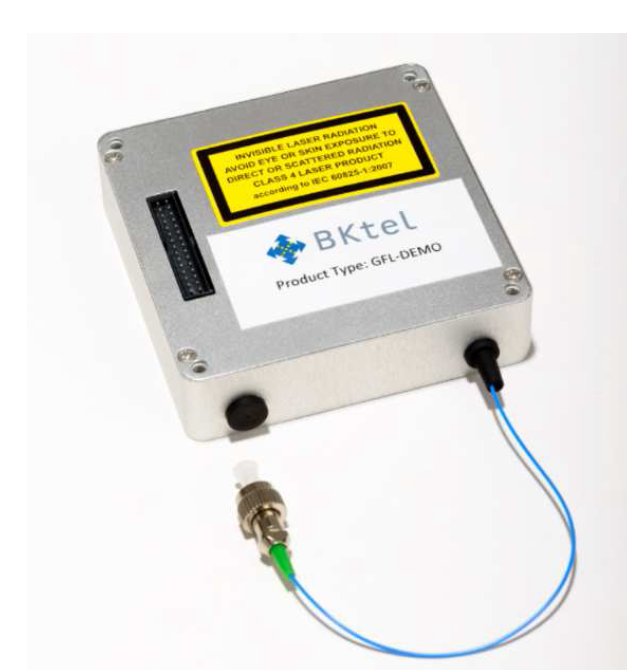
Lidar Lasers are a crucial part of LIDAR systems. LIDAR Systems utilize the light generated by these LIDAR Lasers to illuminate targets or scene with pulsed laser light and measure how long it takes for reflected signals to be returned to a receiver. This information, combined with other data recorded by the system, generates a precise, three-dimensional map with details about the shape and surface of the imaged area. A lidar system includes a laser source (transmitter), a sensitive photodetector (receiver), synchronization and data processing electronics, and either motion-control equipment or solid-state microelectromechanical systems (MEMS)-based components for precise laser scanning to create 3D maps and/or proximity data. See our new Lasers 101 page for in depth information on Solid State Lasers.
LIDAR Lasers are used in a wide range of applications, including airborne topographic mapping, bathymetry (high-resolution mapping of the sea bottom and coastal areas), and lidar for Autonomous vehicles. The wavelength and specifications needed for these applications vary widely, system designers need to understand the physical environment and performance objectives of their application.
For airborne topographic mapping, high peak power, nanosecond pulses, and a wavelength around 1 µm are typically used, in which case the beam is expanded large enough to be considered eye-safe.
For bathymetry, a high-energy, frequency-doubled 532 nm laser source is often used, as the green wavelength represents the best compromise between high transmission in pure water and limited backscattering from submarine particulates.
LIDAR for autonomous vehicles and other high-performance compact lidar for civil and commercial applications, often utilize lasers with a wavelength deemed as eye-safe. Among eye-safe wavelengths, IR lasers emitting around 1.5 µm are often the choice when solid bodies need to be detected as in topography mapping and obstacle avoidance. At the 1.5um wavelength, the atmosphere is quite transparent, and detectors are very efficient.
LIDAR Lasers:
GFL Fiber Laser Series:
BKtel offers a series of compact, air-cooled CW fiber lasers at 1.5µm (1550nm) that can be configured for a wide range of customer applications. The GFL2 IR Laser series can be configured with output power up to 2W.
Features:
- Low power consumption
- Compact package
- Eye-safe Wavelength
Applications:
- Light source for LIDAR
- 3D-scanning
- Autonomous driving
CPFL Fiber Laser Series:
The 1.5µm (1550nm) CPFL fiber lasers series form BKtel is a compact, air-cooled fiber laser series that can also be configured for a wide range of customer applications, including LIDAR. The CPFL offers similar performance characteristics as the GFL, in a smaller package, and average powers up to 1W and pulse widths from 500ps to 10ns and rep rates into the 10 MHz regimes
Features:
- Low power consumption
- Ultra Compact package
Applications:
- Light source for LIDAR
- 3D-scanning
- Autonomous driving
The Wedge Picosecond Laser:
Wedge HF and Wedge XF features pulse widths from 400ps to 3ns and can work from single shot to 100 kHz. Over the years, a variety of customer LIDAR laser have been developed based, on the Wedge series, with output powers up to 225W in the IR and 100W in the Green and >10kHz rep rates. The compact, robust, fixed cavity design of the Wedge series makes it a good fit for both ground based and air-bone LIDAR laser applications.
Features for Wedge Lasers:
- Up to 4mJ pulse energy
- Up to 4MW peak power
- 400ps to 3ns pulse width
- Single shot to 100kHz
- 1064nm, 532nm, 355nm, 266nm, 1.5um, 3.3um
- Monolithic design
- Air cooling
- Low heat waste
- MOPA configurations
Options Available
- Beam expanding and collimating optics
- Fiber Coupling
- Low jitter option
- Extended operating temperature range
- IP68 package
- 28V DC Input for airborne installation
- Circular polarization
- Monitoring photodiode
- Red aiming beam
- Remote control box and software interface
- AC-DC power supply
Applications
- Micromachining of glass
- Specialty marking
- Thin film removal
- LIDAR and bathymetry
- Non-linear spectroscopy
- Harmonic and parametric generation
- Visible to IR OPO pumping
- TeraHertz generation
The AIRTRAC High Energy UV Laser
Areté has developed the next generation of a-thermal lasers providing low divergence and > 70mJ (@1064nm) per pulse. Full NATO STANAG 3733 capability in a very compact, lightweight and low power configuration. The a-thermal design provides high laser pulse energy and low beam divergence in a full system weighing less than 1.5 lbs. AIRTRAC has established a new standard in size for lasers of this class.
Key Features:
- Compact athermal laser resonator
- Solid state technology for increased efficiency and long life performance
- High energy with low beam divergence
- No significant warmup time
- Reduced heat-load: conduction or air cooled
- Continuous operation
- Shock & vibration hardened
RPMC offers a wide selection of lasers designed for Lidar applications. See all our LIDAR Lasers.
Contact us with your requirements and we will help you in selecting the right laser for you application.
RPMC Lasers strives to provide lasers and laser modules at an affordable price while also providing top-notch customer service.
Therefore, we believe we are the best option for ALL your DPSS and Laser Diode needs!
Contact RPMC Lasers by Phone: 636-272-7227 or Email: info@rpmclasers.com

 SHIPS TODAY
SHIPS TODAY 